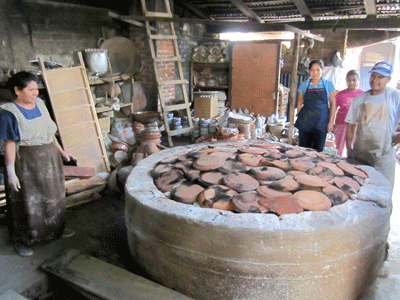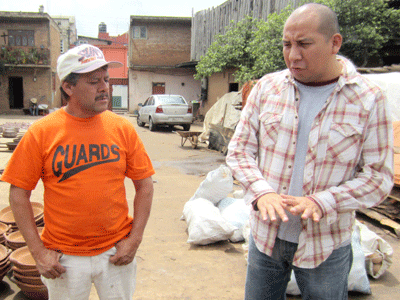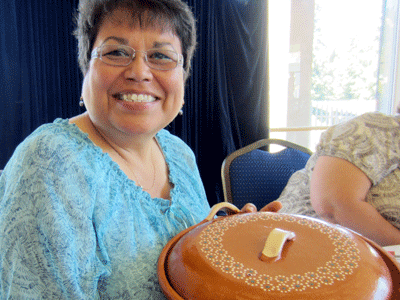
A winning solution to a toxic tradition ---
Mexican pottery is very well known worldwide and the tradition of producing and using clay pots began even before the Spaniards conquered the Aztec empire. The pre-Hispanic cultures produced, exchanged, and cooked in pots made of clay. The arrival of the Spaniards to Mexico brought new techniques to produce pottery similar to that in Europe.
“The Spaniards wanted to see the clay pots produced by the locals to be as shiny and colorful as the Turkish or French ceramic, so they introduced the glaze technique to the process,” says Dirceu Aguila, co-owner of Cocina Sana in Oakland.
“Since then, the communities are using this technique,” added Aguila. “The artisans buy the glaze, which is a yell
 ow powder mainly of lead to make the pot look shiny. They add the powder into water and then cover the whole clay piece with the compound and then put the piece into the oven and when completed it will be shiny, bright and colorful.”
ow powder mainly of lead to make the pot look shiny. They add the powder into water and then cover the whole clay piece with the compound and then put the piece into the oven and when completed it will be shiny, bright and colorful.”Unfortunately, lead is a toxic metal that can damage the nervous system and causes numerous health issues. According to the Contra Costa County Lead Poisoning Prevention Project, lead can be released from the glaze or decoration on the surface of a dish and pass into the food or drink in the dish. This represents a serious health threat, though the bigger threat is to the people producing the pottery.
The cycle of contamination
According to Aguila, more than ninety per cent of Mexican clay pottery producers use lead whether the items are used for cooking, eating, storing, or decoration. The tradition in small towns in Mexico is that the whole family participates and learns the process, so children, pregnant women; and elders get contaminated regularly. Also, since the glaze is added to water, it is easy for families to pour unused amounts into their gardens, patios or sewer, thereby contaminating the environment. The reality is that the contamination is always present in the homes and communities.
When the pottery is sold to the consumer, it will release an amount of lead when used to cook and serve food. The amount of lead released from the dish depends on the amount of lead in the dish, the type of food, and the amount of time the food is in the dish.
“We have a big problem,” states Aguila. “The lead is a toxic element that accumulates in your body - the use of old techniques is having a tremendous, negative impact on Mexican artisans”.
Helping and teaching the community
Aguila and Cocina Sana co-owner Peggy Stein met in Arizona seven year ago in a crafts trade show. Both share a passion for Mexican crafts and helping Mexican rural communities create a responsible and sustainable way of living. Last year, Aguila and Stein launched Cocina Sana, which is a company that trains Mexican artisans to produce quality clay pots without lead. The beautiful pottery is then sold in Los Angeles and the San Francisco Bay Area, providing a healthy income for the artisans and families in Mexico.
“We want to offer an alternative way of living to these communities,” says Aguila.
The process has not been easy - many times the artisans do not see the immediate benefits of producing quality clay pots free of lead. “We start telling the artisan about the economic benefits of making clay pots without lead - when they see the economic benefits, we start working with the families on making them aware of the health reasons,” added Aguila.
It takes up to one year to train a family to produce lead-free pottery to U.S. standards. Cocina Sana’s team works very closely with rural families, always respecting their traditions, customs and habits. The company is working with about fifteen families in Mexico, mainly in Michoacán. Photos of the families and pottery production can be found at www.cocinasanamexico.blogspot.com.
Keeping tradition
 Lito Saldaña, a recognized chef in the Bay Area and owner of Los Moles restaurant in Emeryville, cooks with the cazuelas made by the Mexican artisans who supply Cocina Sana.
Lito Saldaña, a recognized chef in the Bay Area and owner of Los Moles restaurant in Emeryville, cooks with the cazuelas made by the Mexican artisans who supply Cocina Sana. “Mole is a traditional Mexican food that has to be cooked and served on a clay pot or plate,” said Saldaña. “I needed to be sure that the restaurant’s cookware would be safe so I found Cocina Sana and they provided me with my ollas and cazuelas.”
Mexican food experts agree on the benefits of cooking in clay pots, which maintain an even heat and help the food retain its moisture.
“My goal is to offer natural, healthy mole cooked in a traditional way,” adds Saldaña.
Preserving the use of traditional pottery while removing its poisonous element is the goal of this small but growing revolution driven by Cocina Sana, artisans, chefs and consumers.
“We have to do what is correct, what it is fair,” says Aguila. “We want to keep our pottery tradition by creating healthy and sustainable communities.”
